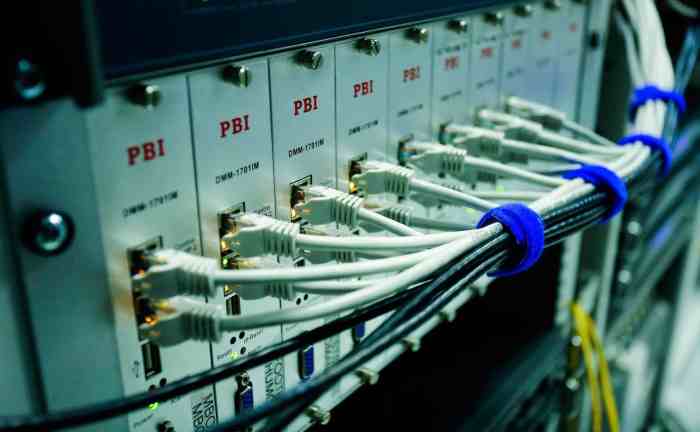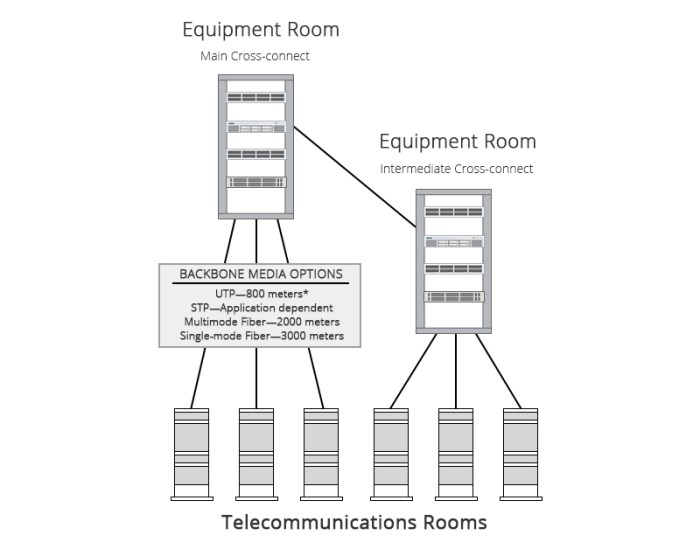Backbone cabling in an enterprise – Backbone cabling, the foundational infrastructure of enterprise networks, plays a pivotal role in transmitting data, connecting devices, and ensuring seamless communication. This comprehensive guide delves into the intricacies of backbone cabling design, implementation, standards, management, security, and future trends, empowering readers with the knowledge to establish and maintain robust network connectivity.
From understanding the types of backbone cabling and their applications to adhering to industry standards and implementing effective management strategies, this guide provides a roadmap for optimizing backbone cabling systems. Additionally, it explores emerging technologies and innovations that are shaping the future of enterprise networks, ensuring readers stay abreast of the latest advancements.
Enterprise Backbone Cabling Overview

Backbone cabling is the foundation of an enterprise network, providing the high-speed connectivity and bandwidth required for critical applications and data transfer. It connects core network devices, such as routers, switches, and servers, forming the backbone of the network infrastructure.
Types of backbone cabling include:
- Copper cabling: Cat5e, Cat6, Cat6a
- Fiber optic cabling: Single-mode, multi-mode
- Coaxial cabling
Backbone Cabling Design and Implementation
Effective backbone cabling design and implementation are crucial for network performance and reliability. Factors to consider include:
- Network topology
- Cabling distance and capacity
- Component compatibility
- Physical environment
Best practices for installation and termination include:
- Proper cable routing and support
- Accurate connector termination
- Labeling and documentation
Backbone Cabling Standards and Protocols
Industry standards and protocols govern backbone cabling design and implementation, ensuring interoperability and performance. Key standards include:
- TIA/EIA-568-C.2
- ISO/IEC 11801
- IEEE 802.3
Adherence to standards ensures compatibility, reduces errors, and improves network efficiency.
Backbone Cabling Management and Maintenance

Effective management and maintenance of backbone cabling systems are essential for ongoing network performance and security. Key practices include:
- Organizing and documenting cabling
- Tracking changes and updates
- Regular inspections and testing
- Preventive maintenance
Proper management and maintenance ensure optimal network performance and reduce the risk of downtime.
Backbone Cabling Security Considerations
Backbone cabling is a potential entry point for security threats. Vulnerabilities include:
- Unauthorized access
- Physical damage
- Electromagnetic interference
Mitigation measures include:
- Physical security measures
- Access control
- Cable shielding and grounding
Backbone Cabling Future Trends and Innovations
Emerging trends in backbone cabling include:
- Increased use of fiber optic cabling
- Higher bandwidth and speed requirements
- Smart cabling systems with self-monitoring and diagnostics
These advancements are shaping the future of enterprise networks, enabling faster, more reliable, and secure data transfer.
FAQ Explained: Backbone Cabling In An Enterprise
What is the purpose of backbone cabling in enterprise networks?
Backbone cabling provides the physical infrastructure for data transmission between network devices, connecting servers, workstations, and other critical components.
What are the different types of backbone cabling commonly used in enterprise environments?
Common types of backbone cabling include copper twisted pair, fiber optic cables, and coaxial cables, each with its own advantages and applications.
What factors should be considered when choosing backbone cabling components?
Factors to consider include data transmission speed, distance requirements, security considerations, and future expansion plans.
What are the best practices for backbone cabling installation and termination?
Best practices include proper cable routing, adherence to industry standards, and meticulous attention to terminations to ensure optimal signal quality.
What are the potential security vulnerabilities associated with backbone cabling?
Backbone cabling can be vulnerable to eavesdropping, data breaches, and physical tampering, necessitating the implementation of robust security measures.